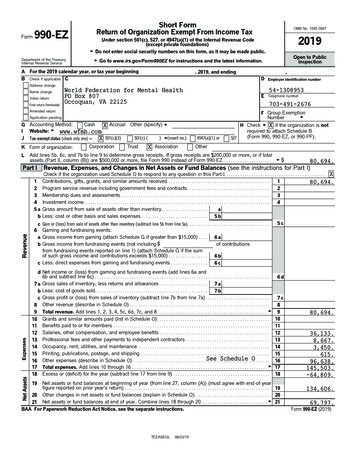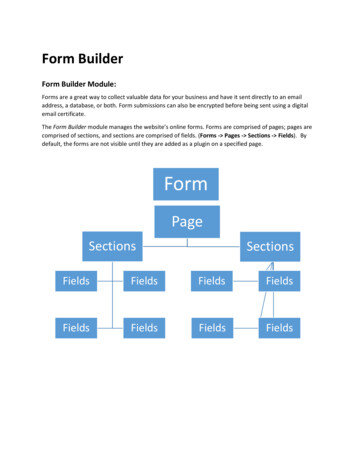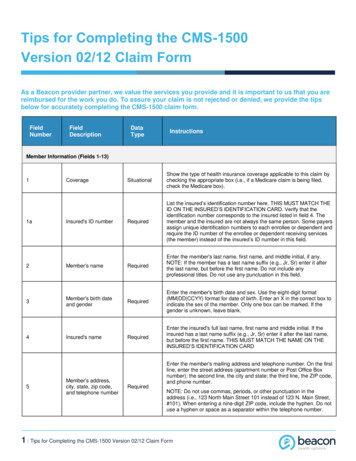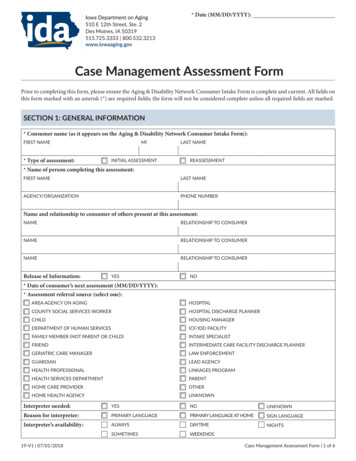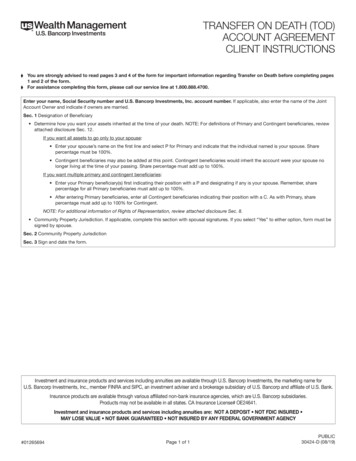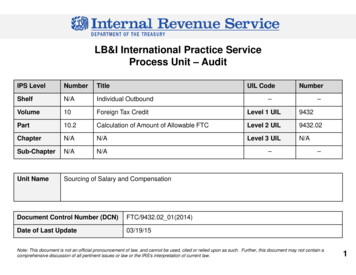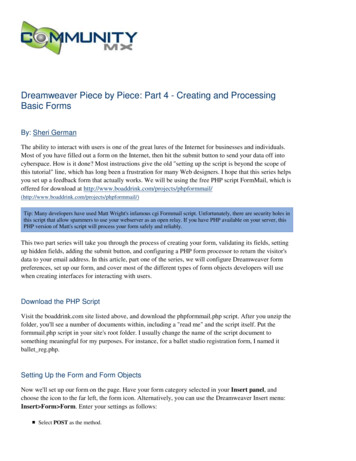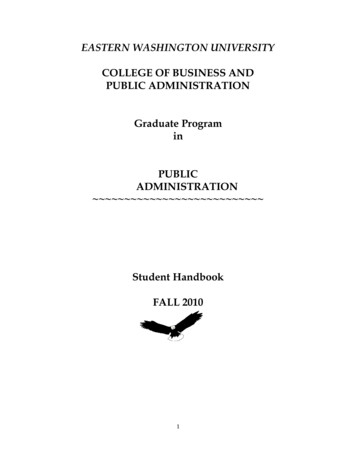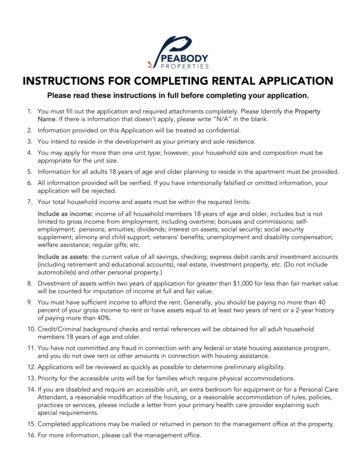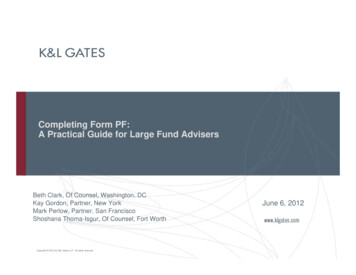
Transcription
Completing Form PF:A Practical Guide for Large Fund AdvisersBeth Clark, Of Counsel, Washington, DCKay Gordon, Partner, New YorkMark Perlow, Partner, San FranciscoShoshana Thoma-Isgur, Of Counsel, Fort WorthCopyright 2012 by K&L Gates LLP. All rights reserved.June 6, 2012
Completing Form PF:A Practical Guide for Large Fund Advisers1.2.3.4.General Form PF requirements for large private fundsLarge fund reporting categoriesLarge fund initial and subsequent filing deadlinesSpecific issues for large private fund advisers whencalculating thresholds and completing Form PF: Related Persons / Sub-Advisers Parallel Structures / Master-Feeder Funds / Fund offunds Private Fund Investments SEC Guidance on Specific Questions CFTC Reporting Requirements1
1. General Form PF RequirementsA Form PF must be filed by all advisers that: Are registered or required to be registered under theInvestment Advisers Act of 1940 Advise one or more “private funds” – issuers exemptfrom registration under the Investment Company Actof 1940 Sections 3(c)(1) or Section 3(c)(7) Manage at least 150 million “regulatory assetsunder management” attributable to private funds asof end of most recent fiscal year2
1. General Form PF RequirementsSeries / Classes Two or more series / classes of interests, eachvalued based on separate investment portfolios,should each be regarded as a private fund Does not apply to side pocket or similararrangements (including in vehicles such as SPVs),which should be aggregated with same series / classportfolio strategy“Regulatory Assets Under Management” Same as Form ADV AUM gross of outstanding indebtedness and otheraccrued but unpaid liabilities3
1. General Form PF RequirementsLarge Private Fund Adviser Thresholds: Reporting requirementsare dependent on what type of funds they advise: Hedge Funds at least 1.5 billion in aggregateRegulatory AUM attributable to private hedge funds as ofthe end of any month in the prior fiscal quarter Liquidity Funds at least 1 billion in combinedRegulatory AUM attributable to liquidity funds andregistered money market funds as of the end of anymonth in the prior fiscal quarter Private Equity Funds at least 2 billion in combinedRegulatory AUM attributable to private equity funds as ofthe end of any month in the prior fiscal quarter4
1. General Form PF RequirementsWho completes what Form PF Sections?Section 1 – All private fund advisersSection 2 – Large Hedge Fund AdvisersSection 3 – Large Liquidity Fund AdvisersSection 4 – Large Private Equity Fund Advisers5
1. General Form PF Requirements - Form PF OverviewSection 1: Section 1a - information regarding adviser’s identity andstatus as a large hedge fund or liquidity fund adviser Section 1b information about each private fund Regulatory AUM and net assets aggregated by types of privatefunds Certain information for each reporting fund (including a breakdownof level 1, 2 and 3 assets and types of investors) Gross and net performance for each reporting fund Section 1c information about the adviser’s hedge funds Description of strategy Percentage of fund’s assets managed using high-frequency tradingstrategies Trading and clearing practices Significant counterparty exposures (including identity ofcounterparties) Fund’s activities outside securities and derivatives markets6
1. General Form PF Requirements - Form PF OverviewSection 2: Section 2a - aggregate information about eachhedge fund Value of assets invested in different types ofsecurities and commodities Duration Weighted average tenure or 10-year bondequivalent of fixed income holdings Value of turnover in certain asset classes Geographical breakdown of investments7
1. General Form PF Requirements - Form PF OverviewSection 2: (Continued) Section 2b - additional information on large hedge funds (NAVof at least 500 million as of the last day of any month in thefiscal quarter prior to the most recently completed quarter) Same information as Section 2a, but on a per fund basis Liquidity Holdings of unencumbered cash Concentration of positions Fund’s base currency Collateral practices with counterparties Risk metrics Financing information Investor information8
1. General Form PF Requirements - Form PF OverviewSection 3: Information about each large liquidity fund (requiredonly by SEC; not CFTC) Method of computation of NAV and NAV as of month ends WAM / WAL – weighted average liquidity fund portfoliomaturity with / without Rule 2a-7(d) exceptions (applicable tomoney market funds) Liquidity – daily, weekly, greater than 397 days Product exposures and portfolio concentrations Financing information Investor concentration and liquidity9
1. General Form PF Requirements - Form PF OverviewSection 4: Information about each large private equity fund Financing and investmentInformation on controlled portfolio companiesGeographical breakdown of investmentsInformation on principal co-investment in portfoliocompanies10
2. Large Fund Reporting CategoriesHedge Fund any private fund having any one of threecommon characteristics of a hedge fund: A performance fee / allocation that may be paid to aninvestment adviser (or its related persons) that takes intoaccount market value (instead of only realized gains) The ability to engage in high leverage or The ability to engage in short selling (except for shortselling that hedges currency exposure or managesduration)Exclusions vehicles established for the purpose of issuingasset-backed securities11
2. Large Fund Reporting Categories“High Leverage” borrowing by a fund In excess of half of NAV (including committed capital) OR Gross notional exposure in excess of twice the fund’s NAV(including committed capital)Note: A private fund is not a hedge fund solely becauseorganizational documents fail to prohibit borrowing or incurringderivative exposures in excess of the specified amounts or fromengaging in short selling, as long as: 1) fund does not engage inthese practices; and 2) reasonable investor would understandfrom fund offering documents that the fund will not engage inthese practices – focus appears to be on what a reasonableinvestor would expect, based on offering documents12
2. Large Fund Reporting CategoriesLiquidity Fund any private fund that seeks to generateincome by investing in short term obligations in order tomaintain a stable NAV per unit or minimize principalvolatility for investorsPrivate Equity Fund Any private fund that is not a hedgefund, liquidity fund, real estate fund, securitized asset fundor venture capital fund and does not provide investors withredemption rights in the ordinary course Definition of “real estate fund,” “securitized asset fund”and “venture capital fund” are narrow and specific, andthus “private equity fund” is a catch-all category13
2. Large Fund Reporting Categories Hedge Fund AUM the portion of the adviser’s Regulatory AUMthat is attributable to hedge funds it advises (a threshold of 1.5billion in hedge fund assets under management for large hedgefund adviser reporting) Liquidity Fund AUM the portion of the adviser’s Regulatory AUMthat is attributable to liquidity funds it advises (including liquidityfunds that are also hedge funds) ( 1 billion in combined liquidityfund and registered money market fund assets under managementfor large liquidity fund adviser reporting; an adviser is, however,only required to report information about unregistered liquidityfunds on Form PF) Private Equity Fund AUM the portion of the adviser’s RegulatoryAUM that is attributable to private equity funds it advises ( 2 billionin private equity fund assets under management for large privateequity fund adviser reporting)14
3. Initial Filing DeadlinesBased on Data as of June 30, 2012 If as of last day of fiscal quarter most recently completed prior to June 15,2012, adviser had: at least 5 billion in combined assets under management attributable toliquidity funds and registered money market funds, file within 15 days ofdeadline (by July 15, 2012) at least 5 billion in assets under management attributable to hedgefunds, file within 60 days of deadline (by August 29, 2012) at least 5 billion in assets under management attributable to privateequity funds, as of the last day of its fiscal year to end on or after June15, 2012 (and assuming a June 30th fiscal-year end), file within 120days of deadline (by October 28, 2012)Based on Data as of December 31, 2012All other advisers, including large private fund advisers under 5 billion AUM –file within 15, 60 and 120 days of filing deadline, as applicable15
3. Subsequent Filing Deadlines Large private equity advisers and smaller private fund advisers must filewithin 120 days of end of adviser’s fiscal year Large hedge fund advisers must file quarterly within 60 days of end ofadviser’s fiscal quarter Large liquidity fund advisers must file quarterly within 15 days of end ofadviser’s fiscal quarter Others: within 120 days of adviser’s fiscal year end Once an adviser becomes subject to quarterly reporting, it is required toupdate information only with respect to the type of private fund that causedit to exceed the large adviser threshold (not with respect to all of its privatefunds each quarter) An adviser must file Form PF to report that it is transitioning to only filingForm PF annually or to report that it no longer meets the requirements forfiling Form PF no later than the last day on which the adviser’s next FormPF update would be timely16
4. Specific Issues – Reporting Thresholds – RelatedPersonsGeneral Guidance: If an adviser filed Form ADV Section 7.B.1 with respect to aprivate fund and is required to file Form PF, that adviser mustinclude the assets in that fund for reporting thresholdpurposes Assets in private funds and parallel managed accounts advisedby the adviser’s non-separately-operated “related persons” mustbe aggregated with the adviser’s assets Include all applicable assets of those “related persons” (even ifthey filed separate ADVs and may file separate Forms PF)17
4. Specific Issues – Reporting Thresholds – RelatedPersons NOTE: One is a separately operated relatedperson if an adviser was not required to completea Schedule D, Section 7.A on that person, i.e.,when: No business dealings in connection with advisory servicesNo shared operationsNo referrals to each otherNo shared supervised persons or premisesNo reason to believe relationship creates a conflict ofinterest18
4. Specific Issues – Reporting Thresholds – RelatedPersons and Sub-Advisers Note: Where two advisers who are “related persons”manage a fund (e.g., a sub-advised fund) and oneadviser reports on the fund, the other adviser doesnot have to report on the fund, but it still needs toinclude that fund’s assets in its reporting thresholdcalculation and, if met, it must still file Form PF Related Note: If adviser that filed Form ADV Section7.B.1 with respect to a private fund is NOT requiredto file Form PF and one or more other advisers tothat fund are required to file Form PF, anotheradviser must include assets of that private fund forreporting threshold purposes19
4. Specific Issues – Reporting Thresholds – RelatedPersons and Sub-Advisers Related Persons (Form ADV, Schedule D, Section7.A Recent SEC guidance: “filing / relying advisers”and SPVs are “related persons” The “filing adviser” must aggregate relying adviser’s assets for thresholdpurposes Affiliated sub-advisers – are “related persons” Advisers filing separate ADVs / Unaffiliated subadvisers – conduct “related person” analysis20
4. Specific Issues – Reporting Thresholds - ParallelStructures, Master/Feeder Funds and Funds of Funds For reporting threshold purposes, a reporting advisermust aggregate: Dependent parallel managed accounts (SAME objective /strategy / substantially same positions as private funds)UNLESS accounts’ gross value EXCEEDS private funds’gross value Parallel funds (SAME objective / strategy / side-by-sideinvestments in substantially SAME positions as privatefunds) Funds that are part of SAME master-feeder arrangement(even if not permitted to aggregate for ADV Sec. 7.B.1) Investments in the equity of other private funds maybe disregarded for threshold calculation purposes21
4. Specific Issues - Individual Fund Reporting –Related persons and Sub-AdvisersGeneral Guidance: If an adviser filed Form ADV Section7.B.1 with respect to a private fund and is required to fileForm PF, that adviser must report on that private fund Related Persons (Form ADV, Schedule D, Section7.A) - May report together on funds they advise, orseparately Affiliated Advisers Advisers filing separate ADVs – may file one FormPF Filing / relying advisers - filing adviser shouldreport on relying adviser’s funds22
4. Specific Issues - Individual Fund Reporting –Related Persons and Sub-Advisers Notes to General Guidance: Only report on funds that adviser and “related persons” listedin Question 1(b) advise If unaffiliated sub-advisers who reported fund on Form ADVare not required to file Form PF, then Form PF reportingadviser is required to report on fund Sub-advised funds will require coordination in advance,particularly where the sub-adviser is unaffiliated Coordination may require amending both advisers’ FormADV23
4. Specific Issues – Individual Fund Reporting –Parallel Structures and Master/Feeder Funds Treatment of assets for reporting purposes: Aggregate assets OR Report on them separately As long as reporting is done consistently throughout Often, but not always, better to aggregate If an adviser aggregates parallel or master-feeder funds,the largest parallel / master fund is the reportingaggregate fund Feeder fund investments in the master fund should bedisregarded but other feeder fund investments should betreated as though they were investments of the aggregatefund24
4. Specific Issues – Individual Fund Reporting –Investments in Other Private Funds Generally: Adviser may disregard a private fund’s equityinvestments in other private funds, BUT Adviser must do so consistently (e.g., do not includeinvestments to determine whether the fund’s borrowingcategorizes it as a “hedge fund” but otherwise disregard) Adviser may not exclude liabilities of the private fund, even ifincurred in connection with an investment in other privatefunds, for threshold calculation and fund reporting purposes Investments in non-private funds, such as registeredinvestment companies, should be counted for all purposes The adviser does not have to look through investments inthose funds unless Form PF requests information regardingthem or their primary purpose is to hold assets or incurleverage as part of the reporting fund’s investment activities25
4. Specific Issues – Individual Fund Reporting –Funds of Funds Direct investments by “funds of funds” in assets thatare not private funds generally must be countedtoward thresholds and included in Form PF reporting This includes assets that are managed by a subadviser, even in funds that are generally managed andmarketed as “funds of funds”26
4. Specific Issues – Individual Fund Reporting –Funds of Funds For each private fund that meets the followingrequirements, the reporting adviser only needs tocomplete Section 1b: Adviser to a private fund that invests substantially all of its assets inequity of private funds [that adviser does not advise] Note: SEC indicated that this distinction between affiliated /unaffiliated will likely go away, AND Aside from private fund investments, holds only cash and cashequivalents and instruments acquired for hedging currencyexposure For all other purposes – disregard the fund E.g.: do not complete Sections 1c or 2c for the fund E.g.: do not include its assets or liabilities in aggregate info(e.g., in Section 2a) E.g.: do not include as a qualifying hedge fund27
4. Specific Issues – Large Fund Individual ReportingSection 1b Update information quarterly Advisers should only report on individual private fundsadvised by related persons listed in Question 1(b) Advisers are not required to report information on parallelmanaged accounts, except in Question 1128
4. Specific Issues – Large Fund Individual ReportingSection 1b (continued) Question 14: Report assets / liabilities broken down according to thecategories of the fair value hierarchy (i.e., Level 1, 2 or3) established under GAAP (FAS 157), but do notneed to classify them by type If GAAP is not used, an adviser can rely on the “fairvalue” calculation procedure in a private fund’sgoverning documents Valuations do not need to be audited Questions 15 &16: “beneficial owners” are same asbeneficial owners under 40 Act Sections 3(c)(1) andqualified purchasers under 3(c)(7).29
4. Specific Issues – Large Fund Individual ReportingSection 1b (continued) Question 17: Performance Report information for most recently completed fiscalyear (or monthly or quarterly information if alreadybeing calculated) Use existing methods for calculating performancereported to investors (or if not reported, usedinternally) Performance numbers do not need to be audited Report performance gross and net of managementfees as well as incentive fees and allocations30
4. Specific Issues – Large Fund Individual ReportingSection 1c Questions 18 – 25: High-level information about eachhedge fund’s potential systemic exposure Update quarterly Do not need to include parallel managed accountswhen reporting information in Section 1c Question 20: Report on investment strategy by categorybased on NAV and (optional) capital allocation31
4. Specific Issues – Large Fund Individual ReportingSection 2b Update information quarterly Questions 29 – 50 “Net Asset Value” defined as gross assets reported inresponse to Question 8 minus outstandingindebtedness or other accrued but unpaid liabilities. Note: Aggregation of parallel funds may result in entirestructure being a qualifying hedge fund, which meansinformation must be reported in Section 2b for eachconstituent hedge fund, even if some of constituentfunds, individually, are not qualifying hedge funds32
4. Specific Issues – Large Fund Individual ReportingSection 2b (continued) Questions 32 – 35: Advisers are allowed to rely on ownmethodologies in responding to these questions, providedthey are consistent with info reported internally and tocurrent and prospective investors Question 33: Report information on unencumbered cash,which is defined to include “overnight repos” used forliquidity management (as long as the assets purchasedare U.S. treasury securities or agency securities)33
4. Specific Issues – Large Fund Individual ReportingSection 2b (continued) Question 40: Report on Value at risk (“VaR”) during thereporting period, but only if regularly calculated for thefunds during the reporting period Note: This information will require input from adviser’s riskassessment personnel. Advisers should start identifyingthem and discussing form requirements with them now toensure timely reporting of information. Question 41: Report other risk metrics consideredimportant for monitoring risk in qualifying hedge funds Note: The information in Form PF will be reviewed by the SEC andwill be incorporated into its examinations of reporting advisers.Information should accurately reflect metrics used Query whether replying “none” means that the SEC staff willconsider you to be “high risk”34
4. Specific Issues – Large Fund Individual ReportingSection 2b (continued) Question 42: Report results of stress tests, if they are aregular part of formal testing An adviser can omit any market factor that it did not regularlyconsider in formal testing, even if the adviser has considered itqualitatively If there are no quantitative models, they are not required to beadded to respond to the question Note: The adviser is required to check off a box to indicate that amarket factor was relevant, but not tested Query whether this possibility virtually compels advisers to stresstest all relevant factors Question 43: Report monthly breakdown of the fund’ssecured and unsecured borrowing, posted collateral valueand credit support, and the types of creditors Note: To respond to this question, an adviser may have to requestinformation from a prime broker35
4. Specific Issues – Large Fund Individual ReportingSection 2b (continued) Questions 46 and 47: Report information on financing liquidityand creditors to which the reporting fund owed amounts inrespect to borrowings at 5% or greater of the reporting fund’snet asset value Note: Financing information in Item D of Section 2b is informationthat FSOC must consider in determining whether to designate anon-bank financial company for FRB supervision Questions 48 – 50: Report percentage of NAV subject to sidepockets, other restrictions on withdrawals and investor liquidity Note: This information and responses to Question 32 (on portfolioliquidity) and Question 46 (on a financing liquidity), is reviewed byFSOC to determine whether a fund may have a mismatch inmaturity or liquidity of its assets and liabilities, which is informationFSOC must consider in determining to designate a non-bankfinancial company for FRB supervision36
4. Specific Issues – Forms CPO-PQR and CTA-PRCFTC adopted CFTC Rule 4.27(d) that, jointly with the SEC,establishes new reporting requirements with respect to privatefunds: Requires all CPOs and CTAs to report certain informationto the CFTC on Forms CPO-PQR and CTA-PR,respectively – no exemption from reporting CPOs dually registered with the SEC and CFTC that fileSections 1 and 2 of Form PF, as applicable, mustgenerally file Schedule A of Form CPO-PQR only Non-dually registered CPOs must file all relevant sectionsof Form CPO-PQR based on certain reporting thresholds All CTAs, regardless of SEC registration, will completeForm CTA-PR Both forms must be filed via NFA’s EasyFile System37
4. Specific Issues – CPO-PQR Schedules, Thresholds,and Deadlines (cont’d) Filing requirements differ based on aggregate gross pool assetsunder management (“Gross AUM”) of a CPO – different from theSEC’s “regulatory assets under management” for Form PF “Regulatory AUM” assets under management attributableto private funds vs. “Pool AUM” assets under managementattributable to commodity pools on any day during thereporting period Large CPO 1.5 billion in pools; Mid-Sized CPO morethan 150 million but less than 1.5 billion in pools; allothers less than 150 million Even if a dually registered CPO files Form PF with the SEC, itmay still need to file Schedules B and/or C if it has pools thatwere not captured on Form PF – dual registrants may reportpools on Form PF even if not a private fund38
4. Specific Issues -- CPO-PQR Schedules, Thresholds, andDeadlinesAssets UnderManagementSchedule ADually registered –Quarterly – 60 daysLarge CPO (at least(also filing Form PF)Schedule BSchedule C 1.5 billion AUM)Dually registered – allAnnually – 90 daysothers (less than 1.5(also filing Form PF)billion AUM)Large CPO (at leastQuarterly – 60 daysQuarterly – 60Quarterly – 60 days 1.5 billion AUM)(not filing Form PF)days (for each(for each “Largepool)Pool”)Mid-Sized CPO (atAnnually – 90 daysAnnually – 90least 150 million(not filing Form PF)days (for eachAUM)pool)Small CPO (less thanAnnually – 90 days 150 million AUM)(not filing Form PF)39
4. Specific Issues – CPO-PQR Initial Filing Deadlines(12/31 fiscal year)Commodity Pool Assets UnderManagementLarge CPOs with at least 5 billion AUMDeadline60 days after September 30, 2012in commodity pools as of last day of fiscalquarter most recently completed prior to(November 29, 2012)September 15, 2012Large CPOs with between 1.5 billion and60 days after December 31, 2012 5 billion AUM in commodity pools as oflast day of fiscal quarter most recently(March 1, 2013)completed prior to December 15, 2012All other CPOs90 days after December 31, 2012(March 31, 2013) Rule 4.27 will become effective on July 2, 2012 and will apply to all registered CPOsregardless of whether they are still relying on Rule 4.13(a)(4) at that time40
4. Specific Issues -- Form CPO-PQR, Schedule ASchedule A seeks basic identifying information about the CPO,including: general information about the CPO (number of employees,name of CCO, number of pools operated) gross and net assets under management information about each of the pools operated (names of coCPOs, foreign registrations, master/feeder status) Information on third party used by the pool (administrators,brokers, trading managers, custodians, auditor, marketers,etc.) change in assets under management and performance monthly rates of return subscription and redemption activity41
4. Specific Issues -- Form CPO-PQR, Schedule B Only required by mid-sized (at least 150 million in pool AUM ) orlarge (at least 1.5 billion in pool AUM) CPOs If completed Sections 1b and 1c of Form PF, Schedule B is onlyrequired for pools that did not meet the definition of Private Fund andthe CPO did not elect to report on Form PF Schedule B seeks information about each pool operated by a CPO,including: breakdown of the assets of the pool by investment strategies, includingquantitative trading algorithms and techniques and concentrations borrowings of the pool and types of creditors pool counterparty and credit exposure (note the definition of “financialinstitution, which Form PF does not define) pool trading and clearing mechanisms value of the pool derivative positions schedule of investments by asset types42
4. Specific Issues -- Form CPO-PQR, Schedule C Schedule C seeks information from Large CPOs on an aggregatebasis as well as on an individual pool basis for each “Large Pool” “Large Pool” any pool that has a net asset value individually, or incombination with any parallel pool structure, of at least 500mm A Large CPO registered as an investment adviser that operatedonly pools that are private funds is deemed to have satisfiedSchedule C filing requirements by completing/filing Section 2 ofForm PF Must file Schedule C for Large Pools that are not private funds orfor which CPO/registered investment adviser did not elect tocomplete Section 2 of Form PF Part 1 for all pools; Part 2 for Large pools43
4. Specific Issues -- CPO-PQR and Funds-of-Funds The treatment of investments in other funds is consistent with theinstructions adopted for Form PF – a CPO may generally exclude anypool assets invested in other unaffiliated pools but must do soconsistently for purposes of both thresholds and answering questions However, CPO must include assets invested in other unaffiliatedpools in response to Schedule A, Question 10 (changes in AUM) Further, CPO may report performance of the entire pool, andneed not recalculate performance to exclude investments inother pools, in response to Schedule A, Question 11 (monthlyrates of return) CPO that operates a pool that invests substantially all of its assets inother pools for which it is not the CPO, and otherwise holds only cashand cash equivalents and instruments acquired to hedge currencyexposure, must complete only Schedule A for that pool44
4. Specific Issues -- Form CTA-PR Only Schedule A of Form CTA-PR was adopted Schedule A requires all CTAs to provide basicinformation about the CTA’s business and the poolsfor which it provides advice Form CTA-PR needs to be filed on an annual basiswithin 45 days after the end of the CTA’s fiscal year Initial filing due on February 14, 2013 for most CTAs45
IV. Confidentiality SEC does not intend to make public any Form PFinformation identifiable to any particular adviser or privatefund SEC and CFTC precluded from being compelled to revealany information except in limited circumstances Information may be shared with other federal departmentsor agencies or SROs Not subject to the Freedom of Information Act Any information may be used in an enforcement actionagainst adviser Congress is entitled to Form PF information, if requested,which introduces the risk of a politically motivated leak46
Panelist Biographies47
Beth ClarkAREAS OF PRACTICEWASHINGTON, D.C. ates.comMs. Clark is Of Counsel in K&L Gates’ Washington, D.C. office. She concentratesher practice in the investment management and securities areas where she advisesparticipants in the financial services industry, including investment advisers, privatefund managers, alternative investment vehicles and brokerage firms. In particular,Ms. Clark focuses on creating and counseling U.S. and non-U.S. private funds,including hedge funds, private equity funds and venture capital funds. She structuresU.S. funds as limited liability companies, limited partnership and trusts andestablishes “offshore” funds in such jurisdictions as Bermuda, the Cayman Islands andthe British Virgin Islands. Ms. Clark prepares and negotiates the necessarydocumentation associated with private securities offerings, including disclosure andorganizational documents, service provider agreements and filings and registrations,such as listing on the Irish Stock Exchange. She advises as to obligations underfederal securities laws, state laws and rules, and self-regulatory organization rules.PROFESSIONAL BACKGROUNDPrior to joining K&L Gates, Ms. Clark was an associate in the securities regulationand enforcement area of a Washington, DC law firm. Before that she practiced inNew York City in the areas of investment management and mergers & acquisitions.BAR MEMBERSHIPDistrict of ColumbiaNew YorkEDUCATIONJ.D., Benjamin N. Cardozo School of Law, 1999 (cum laude; Supervising Editor,Cardozo Law Review)M.A., New York University Graduate School of Arts and Science, 1996B.A., Cornell U
calculation and, if met, it must still file Form PF Related Note: If adviser that filed Form ADV Section 7.B.1 with respect to a private fund is NOT required to file Form PF and one or more other advisers to that fund are required to file Form PF, another adviser must include assets of that private fund for reporting threshold purposes
